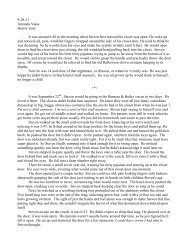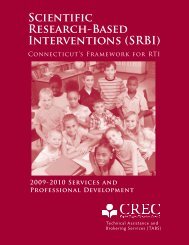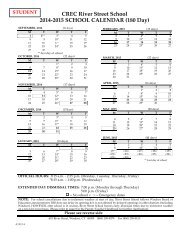Reading and Role Playing: Fiction, Folktales, and Fairy Tale
Reading and Role Playing: Fiction, Folktales, and Fairy Tale
Reading and Role Playing: Fiction, Folktales, and Fairy Tale
You also want an ePaper? Increase the reach of your titles
YUMPU automatically turns print PDFs into web optimized ePapers that Google loves.
<strong>Reading</strong> Curricular Calendar, Second Grade, 2012-20138As kids talk, call out little tips: “What is the wolf feeling right now?” “What does his face looklike?” “What about his body?” Encourage children to refer to the text if they aren’t sure; can theyfind little hints in the pictures <strong>and</strong> words that suggest how a character might be feeling or acting?If one child disagrees with another, encourage both to find evidence in the text that supports theirbeliefs.Of course, as you convey to readers that identifying a character’s feelings is a great start, you willalso want to suggest that ultimately readers, as directors, want to also underst<strong>and</strong> those feelings.This involves asking a provocative question: Why? Of course, readers may just shrug <strong>and</strong> say, “Idon’t know.” And it is often the case that we do not know why a character feels as he does,anymore than we know why we feel as we do, but we develop conjectures, we surmise. To dothis, we reread, we look for clues, we pose theories, we try out different possible interpretations.Your children will do very few of these things unless you help them see the power of inquiry.Remember that kids will be studying persuasive language in writing workshop as well. Theability to apply a particular strategy across disciplines is key to moving up the levels of Webb’sDepth of Knowledge. Again, encourage kids to cite evidence for the conclusions they draw aboutcharacters. Coach them to give reasons for why a character should be dramatized one way versusanother.As you progress through this part of the unit, you’ll also be lifting the level of children’senvisionings <strong>and</strong> enactments. One way to do this is to remind children that readers, like directors,pay attention not only to what <strong>and</strong> why a character does things but also to how the character doesthese things. Does the text give any clues about the character’s gestures? About the way acharacter walks or sits or closes the door? If the text says that a character slumps in the chair,then we need to ask, “Why does she sit like that? Is she tired? Bored? What’s going on?” Wealso pay attention to the way characters talk; the words they choose, their tone of voice, <strong>and</strong> theemotional cues the author implies with dialogue. All of these give hints about what kind ofpeople live in the world of a story. Sometimes the author offers a window into a character’smind; passages may be about a character’s thinking or an explanation of a character’s motives.Characters, like real people, have reasons behind what they do. They are motivated by feelings,situations, <strong>and</strong> relationships. Some predictable motivations that people <strong>and</strong> characters have arejealousy, revenge, <strong>and</strong> fear, to name a few. Children may point out that the text doesn’t alwayssay how a character does an action. You’ll want to help them underst<strong>and</strong> that to be a directormeans that you are always filling in the gaps of a story as you read by drawing on all you learnfrom this book, from other books, <strong>and</strong> from your life.As this part of the unit unfurls, you’ll reach a point when you want to teach readers that we willnot all underst<strong>and</strong> characters in the same way. We will have different ideas about why acharacter feels one way or another or how that character acts. When readers see a patternthroughout the book in the way a character acts, they have probably identified a trait of thatcharacter. You will want to teach children the difference between a feeling <strong>and</strong> a trait. Maybeeven have a feeling chart <strong>and</strong> a few trait charts. A character doesn’t feel kind but acts in waysthat show he is kind. Because we’re often trying to persuade others to see the character as we do,readers need to become accustomed to providing evidence for theories. For instance, “I think inthis part she is really sad because she was left behind, no one is with her, <strong>and</strong> she’s also gettingscared that she’ll be deserted. So I think this part would sound like this.” With your help, in timeUnit Six – <strong>Reading</strong> <strong>and</strong> <strong>Role</strong> <strong>Playing</strong>: <strong>Fiction</strong>, <strong>Folktales</strong>, <strong>and</strong> <strong>Fairy</strong> <strong>Tale</strong>s<strong>Reading</strong> <strong>and</strong> Writing Project, 2012 ©DRAFT
















